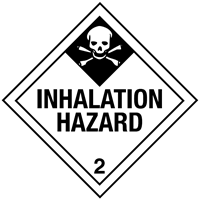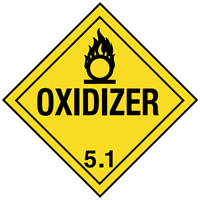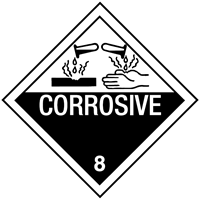
 Print
Print
Chemical Datasheet
Chemical Identifiers
| CAS Number |
UN/NA Number |
DOT Hazard Label |
USCG CHRIS Code |
- 13637-63-3

|
|
- Poison Gas
- Oxidizer
- Corrosive
|
none
|
| NIOSH Pocket Guide |
International Chem Safety Card |
|
none
|
none
|
NFPA 704
data unavailable
General Description
A colorless gas with a sweet odor. Toxic by inhalation and an irritant to skin, eyes and mucus membranes. Corrosive. Heavier than air. Under prolonged exposure to fire or intense heat the containers may violently rupture or rocket. Used as an oxidizer in propellants.
Hazards
Reactivity Alerts
- Strong Oxidizing Agent
- Water-Reactive
- Air-Reactive
Air & Water Reactions
Reacts with water or moisture in the air to produce corrosive hydrofluoric acid and toxic chlorine gas. Interaction with ice at -100°C, or with water vapor above 0°C is extremely vigorous (Christe, K.O. Inorg. Chem. 1972 11, 1220). Hydrochloric acid fumes might also be generated upon reaction with water.
Fire Hazard
Excerpt from ERG Guide 124 [Gases - Toxic and/or Corrosive - Oxidizing]:
Substance does not burn but will support combustion. Vapors from liquefied gas are initially heavier than air and spread along ground. These are strong oxidizers and will react vigorously or explosively with many materials including fuels. May ignite combustibles (wood, paper, oil, clothing, etc.). Some will react violently with air, moist air and/or water. Cylinders exposed to fire may vent and release toxic and/or corrosive gas through pressure relief devices. Containers may explode when heated. Ruptured cylinders may rocket. (ERG, 2024)
Health Hazard
Excerpt from ERG Guide 124 [Gases - Toxic and/or Corrosive - Oxidizing]:
TOXIC and/or CORROSIVE; may be fatal if inhaled or absorbed through skin. Fire will produce irritating, corrosive and/or toxic gases. Contact with gas or liquefied gas may cause burns, severe injury and/or frostbite. Runoff from fire control or dilution water may cause environmental contamination. (ERG, 2024)
Reactivity Profile
CHLORINE PENTAFLUORIDE is a strong oxidizing agent. Nonflammable, but likely to react vigorously on contact with combustible materials. Reacts violently with lithium, calcium. Emits highly toxic fluoride and chloride fumes when heated to decomposition. Extremely vigorous reaction with water, steam, even ice [Pilipovich D. et al., Inorg. Chem., 1967, 6, p. 1918]. Very vigorous reaction with anhydrous nitric acid even at -100°C [Christie, K. O., Inorg. Chem. 1992, 11, p. 1220].
Belongs to the Following Reactive Group(s)
- Oxidizing Agents, Strong
- Halogenating Agents
Potentially Incompatible Absorbents
Use caution: Liquids with this reactive group classification have been
known to react with the
absorbents
listed below.
- Cellulose-Based Absorbents
- Mineral-Based & Clay-Based Absorbents
- Expanded Polymeric Absorbents
- Dirt/Earth
Response Recommendations
Isolation and Evacuation
Excerpt from ERG Guide 124 [Gases - Toxic and/or Corrosive - Oxidizing]:
IMMEDIATE PRECAUTIONARY MEASURE: Isolate spill or leak area for at least 100 meters (330 feet) in all directions.
SPILL: See ERG Table 1 - Initial Isolation and Protective Action Distances on the UN/NA 2548 datasheet.
FIRE: If tank, rail tank car or highway tank is involved in a fire, ISOLATE for 800 meters (1/2 mile) in all directions; also, consider initial evacuation for 800 meters (1/2 mile) in all directions. (ERG, 2024)
Firefighting
Excerpt from ERG Guide 124 [Gases - Toxic and/or Corrosive - Oxidizing]:
CAUTION: These materials do not burn but will support combustion. Some will react violently with water.
SMALL FIRE: Contain fire and let burn. If fire must be fought, water spray or fog is recommended. Water only; no dry chemical, CO2 or Halon®. Do not get water inside containers. If it can be done safely, move undamaged containers away from the area around the fire. Damaged cylinders should be handled only by specialists.
FIRE INVOLVING TANKS: Fight fire from maximum distance or use unmanned master stream devices or monitor nozzles. Cool containers with flooding quantities of water until well after fire is out. Do not direct water at source of leak or safety devices; icing may occur. Withdraw immediately in case of rising sound from venting safety devices or discoloration of tank. ALWAYS stay away from tanks in direct contact with flames. For massive fire, use unmanned master stream devices or monitor nozzles; if this is impossible, withdraw from area and let fire burn. (ERG, 2024)
Non-Fire Response
Excerpt from ERG Guide 124 [Gases - Toxic and/or Corrosive - Oxidizing]:
Do not touch or walk through spilled material. Keep combustibles (wood, paper, oil, etc.) away from spilled material. Stop leak if you can do it without risk. Use water spray to reduce vapors or divert vapor cloud drift. Avoid allowing water runoff to contact spilled material. Do not direct water at spill or source of leak. If possible, turn leaking containers so that gas escapes rather than liquid. Prevent entry into waterways, sewers, basements or confined areas. Isolate area until gas has dispersed. Ventilate the area. (ERG, 2024)
Protective Clothing
Excerpt from ERG Guide 124 [Gases - Toxic and/or Corrosive - Oxidizing]:
Wear positive pressure self-contained breathing apparatus (SCBA). Wear chemical protective clothing that is specifically recommended by the manufacturer when there is NO RISK OF FIRE. Structural firefighters' protective clothing provides thermal protection but only limited chemical protection. (ERG, 2024)
DuPont Tychem® Suit Fabrics
No information available.
First Aid
Excerpt from ERG Guide 124 [Gases - Toxic and/or Corrosive - Oxidizing]:
Refer to the "General First Aid" section. Specific First Aid: Clothing frozen to the skin should be thawed before being removed. (ERG, 2024)
Physical Properties
Flash Point: data unavailable
Lower Explosive Limit (LEL): data unavailable
Upper Explosive Limit (UEL): data unavailable
Autoignition Temperature: data unavailable
Melting Point: data unavailable
Vapor Pressure: data unavailable
Vapor Density (Relative to Air): data unavailable
Specific Gravity: data unavailable
Boiling Point: data unavailable
Molecular Weight:
130.443
Water Solubility: data unavailable
Ionization Energy/Potential: data unavailable
IDLH:
1.7 ppm
[From IDLH Table: Chlorine Pentafluoride]
(NIOSH, 2024)
AEGLs (Acute Exposure Guideline Levels)
Final AEGLs for Chlorine pentafluoride (13637-63-3)
| Exposure Period |
AEGL-1 |
AEGL-2 |
AEGL-3 |
| 10 minutes |
NR |
0.7 ppm |
21 ppm |
| 30 minutes |
NR |
0.39 ppm |
12 ppm |
| 60 minutes |
NR |
0.17 ppm |
8 ppm |
| 4 hours |
NR |
0.082 ppm |
3.9 ppm |
| 8 hours |
NR |
0.057 ppm |
2.7 ppm |
(NAC/NRC, 2024)
ERPGs (Emergency Response Planning Guidelines)
No ERPG information available.
PACs (Protective Action Criteria)
| Chemical |
PAC-1 |
PAC-2 |
PAC-3 |
| Chlorine pentafluoride (13637-63-3)
|
0.015 ppm |
0.17 ppm |
8 ppm |
(DOE, 2024)
Regulatory Information
EPA Consolidated List of Lists
No regulatory information available.
CISA Chemical Facility Anti-Terrorism Standards (CFATS)
|
RELEASE |
THEFT |
SABOTAGE |
| Chemical of Interest |
CAS Number |
Min Conc |
STQ |
Security
Issue |
Min Conc |
STQ |
Security
Issue |
Min Conc |
STQ |
Security
Issue |
| Chlorine pentafluoride |
13637-63-3 |
|
|
|
4.07 % |
15 pounds |
WME |
|
|
|
(CISA, 2007)
OSHA Process Safety Management (PSM) Standard List
| Chemical Name |
CAS Number |
Threshold Quantity (TQ) |
| Chlorine Pentrafluoride |
13637-63-3 |
1000 pounds |
(OSHA, 2019)
Alternate Chemical Names




 Print
Print


